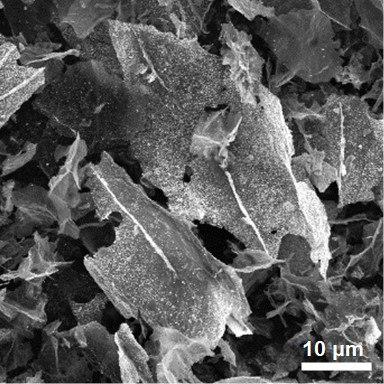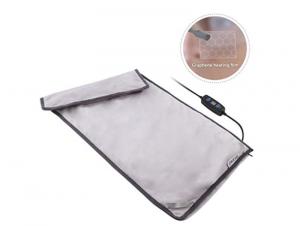The Graphene-Info Newsletter, February 2018
Published: Mon, 03/05/18
Graphene-enhanced sodium-ion batteries show promise as cheap, effective lithium alternative
Researchers at Washington State University are working on graphene-based sodium-ion batteries that might provide a less expensive, viable alternative to lithium-ion batteries.
The researchers used tin oxide nanocrystals supported on a graphene structure to vastly improve the battery. The team explained that technology also could be used in lithium-ion batteries, making it more attractive for manufacturing.The research shows that the material greatly improved the charging capacity and rate of both types of batteries, and the hybrid material “exhibited outstanding electrochemical performance,” according to the team. The researchers also tested the materials in a full battery.
Recent work by Rice University shows graphene-printed toasts and detects metal in ‘metal-free’ graphene catalysts
Scientists at Rice University have enhanced their formerly invented LIG technique to produce what may become a new class of edible electronics. The Rice lab of Prof. James Tour is investigating ways to write graphene patterns onto food and other materials to embed conductive identification tags and sensors into the products themselves.
"This is not ink," Tour said. "This is taking the material itself and converting it into graphene". The process is an extension of the Tour lab's perception that anything with adequate carbon content can be turned into graphene. In recent years, the lab has developed and expanded upon its method to make graphene foam by using a commercial laser to transform the top layer of an inexpensive polymer film.
Additional work by Rice researchers, led by Prof. James Tour, along with teams from the University of Texas at San Antonio and the Chinese Academy of Sciences, Beijing, China has detected a deception in graphene catalysts that, until now, has gone unnoticed. Trace quantities of manganese contamination from graphite precursors or reactants hide in the graphene lattice, turning what was seen as ‘metal-free’ materials into ones containing metal. Because the contrast between carbon and manganese atoms is so slight, trace atoms of the contaminants can't be seen with traditional characterization techniques like X-ray diffraction and X-ray photoelectron spectroscopy (XPS).
Australian CSIRO develops promising graphene-based water filtration membrane
Scientists from the Australian Commonwealth Scientific and Industrial Research Organisation (CSIRO) have used their own type of graphene called "GraphAir" to develop a water filter membrane that is reportedly capable of making water from Sydney Harbor drinkable.
The membrane makes water purification simpler, more effective and quicker, say CSIRO scientists. “Conventional water filter membranes used in water purification are made from polymers (plastics) and cannot handle a diverse mix of contaminants, they clog or allow contaminants to pass through, so they have to be separated out before the water is filtered”, they said. “This technology can create clean drinking water, regardless of how dirty it is, in a single step.”
CSIRO developed the graphene membrane and placed it over a regular commercial-grade water filtering membrane. Tests using water samples from Sydney Harbor showed that without Graphair the filtration rate halved in 72 hours, as contaminants clogged the filter’s membrane. After the Graphair was added, scientists say the filter did not clog, more contaminants were filtered and the water was determined safe to drink.
MIT team designs a graphene-based system that draws power from daily temperature swings
Researchers at MIT have developed a novel graphene-assisted method to convert temperature fluctuations into electrical power. Thermoelectric devices usually generate power when one side of the device is a different temperature from the other. In the team's design, however, instead of requiring two different temperature inputs at the same time, the new system takes advantage of the swings in ambient temperature that occur during the day-night cycle.
The new system, called a thermal resonator, could enable continuous, years-long operation of remote sensing systems, for example, without requiring other power sources or batteries, the researchers say. The thermal resonator was shown to outperform an identically sized, commercial pyroelectric material — an established method for converting temperature fluctuations to electricity — by factor of more than three in terms of power per area.
Graphene in under 2 minutes - a new Graphene-Info video
Graphene-Info presents a new video that gives an introduction to graphene.
This is going to be the first in a series of graphene videos that give short and easy-to-follow introductions to various graphene topics. Enjoy!
Graphene-based heating devices hit the market
Several companies in China are now commercializing graphene-based heating elements, embedded in wearables and other devices. Many such devices are now available, shipping globally via retailers such as Amazon and others.
Graphene is an excellent thermal conductor, and using it for heating devices is somewhat surprising. The producers of these devices explain that graphene is strong, thin and flexible, and it provides "pure far infrared radiation" and is also safer and more environmentally-friendly compared to other alternatives. Whether this is actually so is an open question.
First Graphene provides updates on the BEST Battery project and reports the commencement of production at its new plant
First Graphene has provided an update on its work with the Swinburne University of Technology (SUT) on the development of the BEST Battery.
FGR supplied the following highlights: a pilot production line for manufacturing the BEST Battery has been set up, able to manufacture a commercial prototype of BEST Battery that reportedly meets the industrial requirements and standards. It was said that the single layer BEST Battery is able to hold LED light for 15-20 minutes on only several seconds of charging time, and that an eight layer prototype was achieved. Scale-up work is continuing with steady improvements in performance, as does the optimization of design aspects and processes. FGR reports the use of raw materials to improve efficiencies in both cost and performance. Also reported were prototype designs for graphene-based flexible smart watch bands that will reportedly offer great advantages over existing watches in weight, charging times and battery life.
In addition, FGR shared what it views as a significant milestone, "not just for the Company but also for the global graphene industry" - the commencement of production from its CGF at Henderson, Western Australia.
The India-based Centre for Materials for Electronics Technology (C-MET) has designed and developed a graphene-based emergency lamp which can be fully charged in less than two minutes.
Graphene 3D Lab patents a graphene-based technology to harvest thermal energy produced in Bitcoin mining.
Scientists from St. Petersburg University and Tomsk University in Russia, along with teams at the Max Planck Institute in Germany and University of the Basque Country, Spain, have modified graphene in such a way that it has taken the properties of cobalt and gold: magnetism and spin–orbit interaction.
Researchers from the University of British Columbia’s Okanagan campus have created a graphene-based wearable device capable of sensing and understanding complex human motion.
Researchers from the UCLA, Mississippi State Universitym University of Nevada and China's Central South have designed an efficient and long-lasting graphene-based electrode for supercapacitors. The device’s design was inspired by the structure and function of leaves on tree branches, and it is said to be more than 10 times more efficient than other designs.
Advanced materials group Versarien has signed an agreement with shoemaker Vivobarefoot to collaborate on developing graphene-enhanced footwear.
Versarien has announced that the signing of an agreement to develop a range of graphene-based sensor technologies to enable the creation of digital bandages and wound dressings capable of various forms of physiological movement and excretion detection.
The Department of Energy (DoE) has awarded $2.9 million to a project that develops a graphene oxide-based membrane process for post-combustion carbon capture.
A team of Chinese scientists has developed graphene-based high temperature-resistant memristors, which are leading candidates for future storage and neuromorphic computing, with potential to address existing challenges in the development of electronic devices.
Researchers from the Chinese Harbin Institute of Technology have developed an intriguing material that combines a soft, self-healing polymer with a tough layer of graphene oxide and could one day form the basis of ultra-tough scratch resistant coatings.
Directa Plus has announced the launch of two new textile collections containing its Graphene Plus (G+) by Colmar, a high-end sports and activewear company, and Eurojersey, a producer of high quality warp-knit technical fabrics under its Sensitive Fabrics brand.
Graphmatech, a Sweden-based startup that develops graphene-based nanocomposite materials, has announced a recent breakthrough made at Uppsala University which reportedly "solves the practical implementation issues of graphene".
A collaboration between Spanish research institutes—led by the nanoGUNE Cooperative Research Center (CIC)—has achieved a breakthrough in so-called molecular electronics by devising a way to connect magnetic porphyrin molecules to graphene nanoribbons.
Do you have a friend or a colleague that might be interested in Graphene technology? Forward this mail to update him on the world of Graphene.
If you received this email from a friend, subscribe to this newsletter here!










